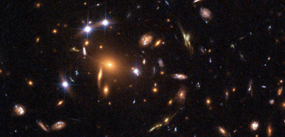Syllabus
Downloadable syllabus [pdf]
AST 307
"Introductory Astronomy"
Spring 2013
Professor Gregory A. Shields
TTh 11-12:30 (Unique No. 47955)
RLM 5.104
Course Description
What are the stars? How old are they, how were they born, and when will they die? How does our Milky Way compare to other galaxies? How did the Universe begin and how did it evolve into its present form? What processes led to the formation of stars and planets? What is the future of the solar system, the Galaxy, and the universe? Are we alone in the universe?
These questions fascinate everyone. Astronomers have some answers, but many questions remain. This course gives a survey of modern astronomy. Topics include the solar system, exoplanets, stars, interstellar gas, galaxies, quasars, the Big Bang, dark matter and dark energy, and life in the universe. The goals are to leave the student with a picture of our place in the universe and a foundation in the use of observational technique and physical laws to understand nature.
Lectures will be illustrated with images and videos. Mathematics will include high school algebra but no calculus. Some homework assignments may involve nighttime observations.
This course carries the Quantitative Reasoning flag.
Prerequisite. Math 305G or equivalent
Instructor. Professor Raphael Flauger. Office: RLM 9.301. Phone: . E-mail: shieldsga@austin.utexas.edu. Office Hours:
Web page: https://www.as.utexas.edu/~shields/shields.html
Teaching Assistant: Mr. Rebecca Larson. Office: RLM 16.308. Phone: (512) 471-3453. E-mail: rlarson@astro.as.utexas.edu. Office Hours:
Grading: The course grade will be based on three one-hour exams in class, and homework. (No final exam.) Exams will be closed book and will involve both multiple choice and essay questions. Exams will cover lectures, assigned reading, and homework. Make-up tests will not be given except for a compelling reason presented in advance or in case of illness. Exam weights and tentative dates are:
|
First exam |
20% |
|
|
|
25% |
|
|
Third exam |
25% |
|
Homework will count 30%, based on grading of selected problems from homework sets. Course grades will use the plus/minus system.
Help sessions. Mondays 5:30–6:30 in RLM 15.216B. For help with course material, homework and exam preparation.
Required text. Jeffrey Bennett et al. “The Cosmic Perspective” (2010, 6th edition, ISBN 978-0-321-63366-8, Pearson Education, Inc.). [Note: there are abbreviated versions of this book, devoted to “The Solar System” or to “Stars, Galaxies, and Cosmology” as well as an “Essential” version. We will use the full version. The publisher provides an on-line supplement called “Mastering Astronomy”. This is not a required part of the course, but some students find it helpful. It can be purchased at www.masteringastronomy.com. There are two versions, one including an e-text version of the book, with identical layout as the hard copy. If you like e-books, this would be a less expensive alternative to the printed book. Also, there is a three-ring-binder version that is less expensive than the standard print version but may be difficult to resell.]
Drop Dates. January 30 is the last day to drop a class for a possible refund. April 1 is the last day to change to or from the credit/no credit basis. After April 1, you may drop the course or withdraw from the University only for urgent and substantiated, nonacademic reasons. Please consult the University's published calendar (http://registrar.utexas.edu) to verify these dates and for further information.
Star Parties. Every Wednesday evening, if the weather is clear, there will be astronomical viewing with the 16-inch telescope on the roof of RLM Hall. These sessions will start about 7 p.m. during standard time and 8 p.m. when daylight saving time is in effect. There is also a 9-inch telescope on Painter Hall that is open to UT students on Friday evenings and to the general public on Saturday evenings. For observing hours, see the Department of Astronomy public outreach Web page at http://outreach.as.utexas.edu/public. You can use the 9-inch yourself if you are checked out on it. McDonald Observatory in west Texas has star parties and public nights (see http://mcdonaldobservatory.org/visitors; phone 471-5285).
About the Instructor: Professor Shields was born in Los Angeles and grew up in Nebraska and Kansas. He earned a B.S. in Physics from Stanford University in 1968 and a Ph.D. in Astronomy at Caltech in 1973. Following a postdoctoral fellowship at Harvard, he joined the UT faculty in 1974. He now holds the title of The Jane and Roland Blumberg Centennial Professor in Astronomy, and served as Chairman of the Department of Astronomy from 1990 to 1994. He teaches both graduate and undergraduate courses at UT. His research interests include studies of nebulae, quasars, and black holes, and he has published numerous research papers and popular articles.
Other Astronomy Courses. For other courses offered by the Department of Astronomy, see https://www.as.utexas.edu or the UT Undergraduate Catalog or the UT Course Schedule (http://registrar.utexas.edu).
